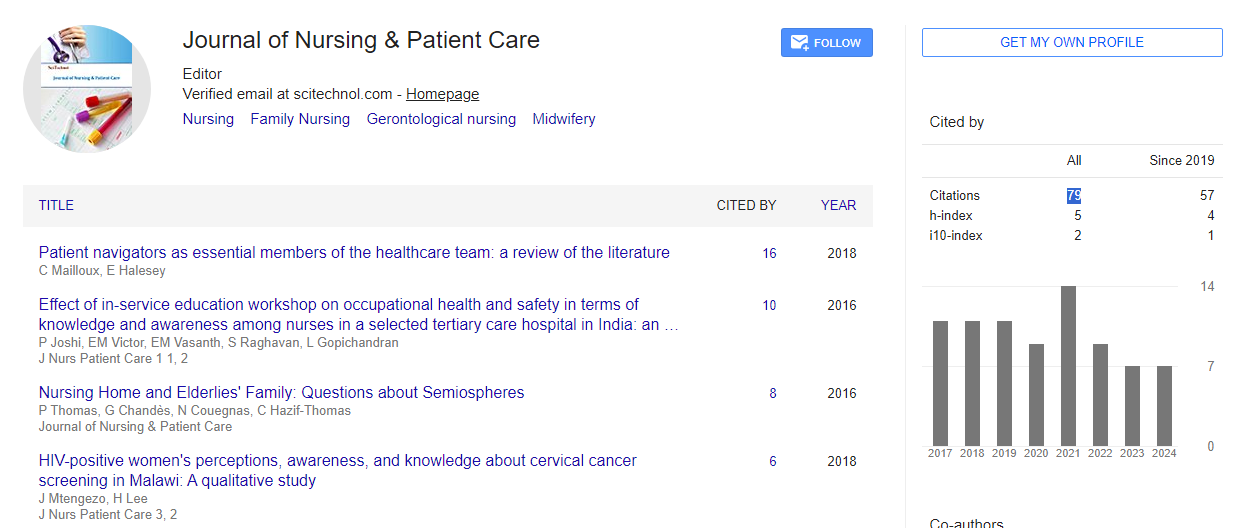Opinion Article, J Nurs Patient Care Vol: 9 Issue: 4
Nursing Strategies for Managing Pain and Enhancing Comfort in Acute and Chronic Conditions
Kumsal Selin*
1Department of Palliative Care, Tufts University School of Medicine, Boston,USA
*Corresponding Author: Kumsal Selin,
Department of Palliative Care, Tufts
University School of Medicine, Boston,USA
E-mail: selinku@msal.edu
Received date: 23 November, 2024, Manuscript No. JNPC-24-155456;
Editor assigned date: 25 November, 2024, PreQC No. JNPC-24-155456 (PQ);
Reviewed date: 09 December, 2024, QC No. JNPC-24-155456;
Revised date: 17 December, 2024, Manuscript No. JNPC-24-155456 (R);
Published date: 24 December, 2024, DOI: 10.4172/2573-4571.1000079.
Citation: Selin K (2024) Nursing Strategies for Managing Pain and Enhancing Comfort in Acute and Chronic Conditions. J Nurs Patient Care 9:4.
Description
Pain management is a critical aspect of nursing care, especially for patients suffering from acute or chronic conditions. Effective pain management not only improves the quality of life for patients but also helps in their recovery, reduces complications and enhances their overall happiness. Nurses, as primary caregivers, play a significant role in identifying, assessing and managing pain through a variety of strategies that are personalized to the individual needs of the patient. These strategies are essential for both acute pain, which arises suddenly due to injury or surgery and chronic pain, which persists over time and is often associated with conditions like arthritis, cancer or neuropathy. A comprehensive and individualized pain assessment is the first and most important step in managing pain. Nurses must take a complete approach to assess pain, considering not only the physical aspects but also the emotional, psychological and social dimensions of the patient’s experience. For patients with chronic pain or those unable to communicate effectively, observational skills become essential. Nurses should observe signs of distress, changes in behavior or any physical indicators of discomfort, ensuring that pain management is not neglected, even in non-verbal patients.
Once pain has been assessed, nurses can implement a variety of pharmacological and non-pharmacological interventions. Pharmacological interventions, such as analgesics are often the first line of treatment for pain relief. For acute pain, non-opioid medications like acetaminophen are commonly used, with opioids being prescribed for more severe pain. However, opioid use should be carefully monitored due to the risk of addiction and side effects, especially in chronic pain management. Nurses play a vital role in monitoring the effectiveness of these medications, adjusting dosages as needed and managing any adverse reactions or complications. For chronic pain, a combination of medications, including antidepressants, anticonvulsants and longacting opioids, may be necessary, but it is essential to balance efficacy with the potential for dependence.
Nurses also play a critical role in educating patients and their families about pain management strategies. Patient education should include information on medication administration, potential side effects, the importance of observing to prescribed therapies, and the benefits of non-pharmacological approaches. Educating patients about the biopsychosocial model of pain that pain is not only a physical sensation but is influenced by emotional, cognitive and social factors helps them understand the importance of addressing all aspects of their happiness. Empowering patients with knowledge about their condition and available treatments can increase their sense of control and improve observance to pain management strategies. In addition to direct care, nurses must also advocate for their patients by working within multidisciplinary teams. Collaboration with physicians, pharmacists, physical therapists and social workers is essential in providing comprehensive pain management plans that address both the physical and emotional needs of the patient.
Conclusion
Managing pain and enhancing comfort in patients with acute and chronic conditions is a multifaceted challenge that requires a comprehensive approach. Nurses play an essential role in assessing, implementing and evaluating both pharmacological and nonpharmacological pain management strategies. By using a combination of pain assessment tools, medications, relaxation techniques, physical interventions and patient education, nurses can effectively reduce pain and improve comfort for their patients. Ultimately, the goal is to enhance the patient’s quality of life, promote recovery and prevent the debilitating effects of untreated pain. As pain management continues to evolve, nurses remain at the focus of advocating for effective, general care that addresses the diverse needs of all patients.
 Spanish
Spanish  Chinese
Chinese  Russian
Russian  German
German  French
French  Japanese
Japanese  Portuguese
Portuguese  Hindi
Hindi 